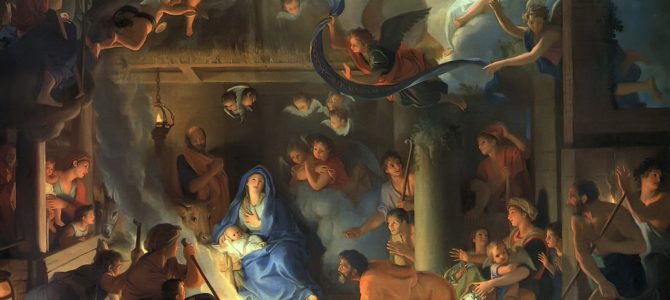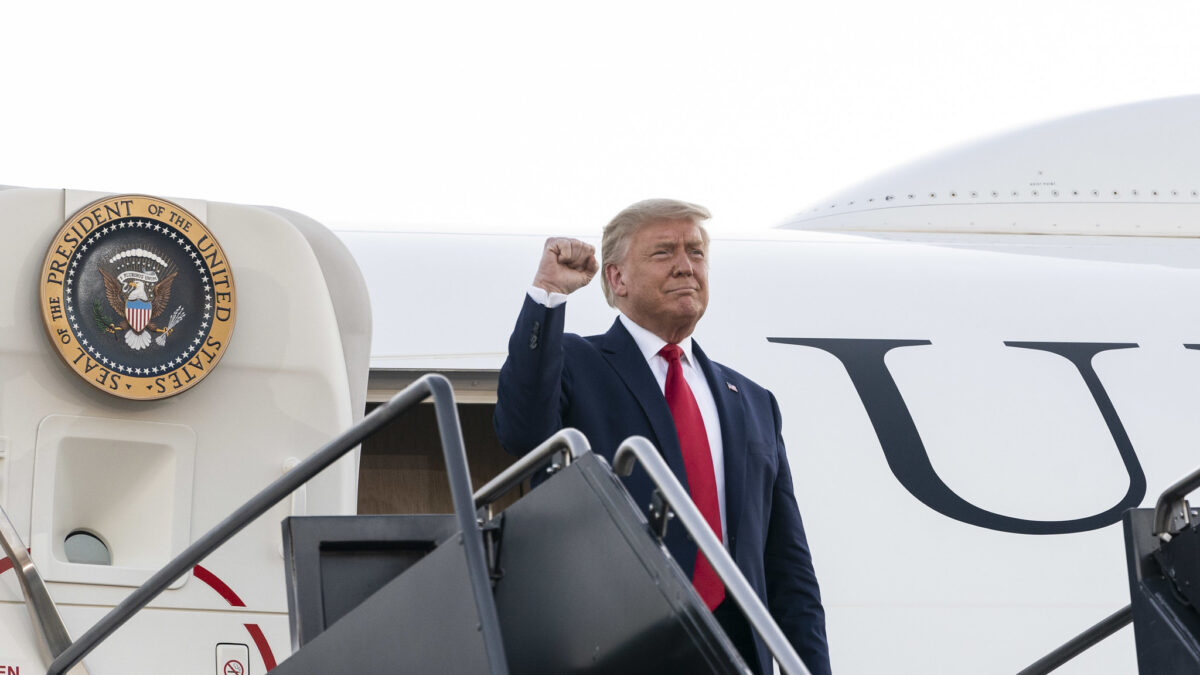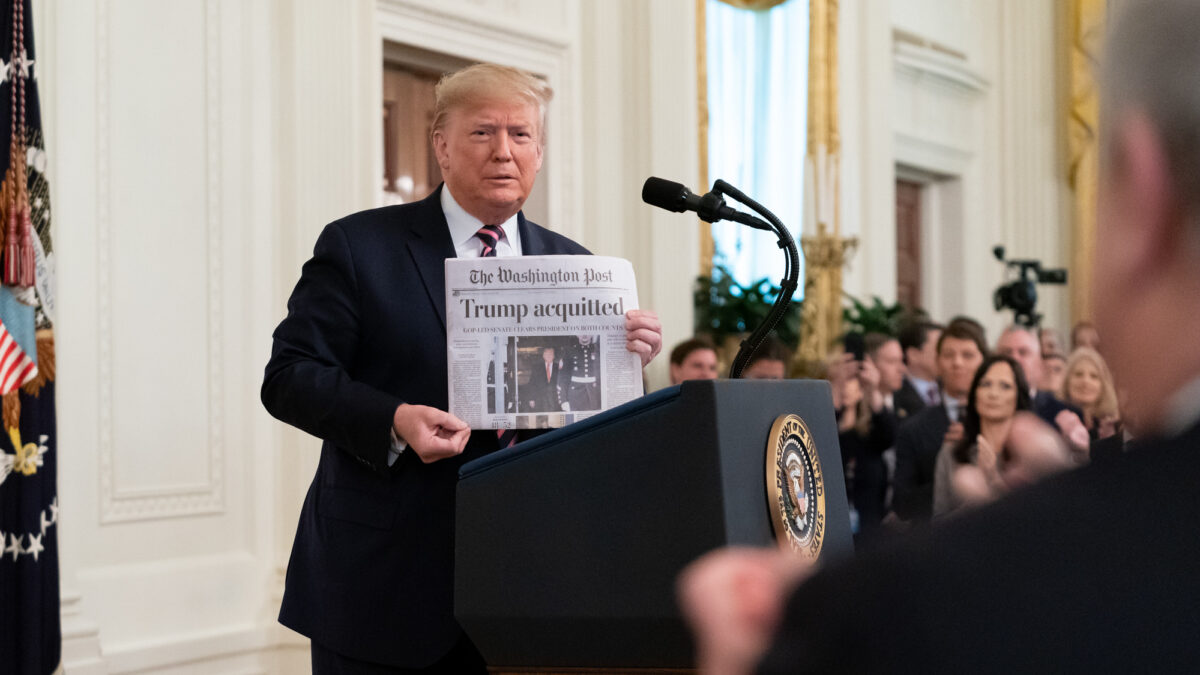
Countless works of art depict the birth of Jesus. At this time of year, even in our increasingly secular society, these images appear on everything from decorations and ornaments to greeting cards and postage stamps. They represent a fusion of the words of Scripture with products of the artistic imagination, and they’ve been popular for nearly 2,000 years now. Indeed, some of the earliest Christian art in existence is of scenes from the Nativity.
When looking at this art, it’s easy to focus on the representations of people and settings that we can overlook the appearance of text in these images. So let’s consider three works by three Old Master painters that depict three important moments in the story of Christ’s birth, and just so happen to feature some text as well. I think you’ll agree that this element can play just as important a part in the visual narrative, as in the written narrative.
The Word Was Made Flesh
If you’ve seen the British television series “Sherlock,” you’ll recall that sometimes special effects make words appear to float about in the scene. This often happens when Sherlock is trying to get through a number of distractions to focus on what is really important to the story. Long before movies and TV, this technique turned up in Christian art, and here in Washington, we have a very fine example of it.
One of the jewels in the collection of the National Gallery of Art is “The Annunciation” by the Flemish painter Jan Van Eyck (c. 1390-1441), which was painted sometime between 1434-36. This wing of a now-lost triptych depicts the Bible story told in Luke 1:26-38, in which the angel Gabriel announces to the Virgin Mary that she has been chosen to be the mother of the Messiah, and Mary agrees to accept God’s Will. Although Van Eyck’s painting is referencing the Gospel of Luke, it is also an artistic representation of the lofty words of the prologue in John’s gospel: “And the Word was made flesh, and dwelt among us” (John 1:14).

The wealth of detail in this painting delights our eyes, but the use of text is very important to this composition. If you look closely, coming out of the mouth of Gabriel, almost like a medieval cartoon bubble, we can see tiny gold letters that read, “Ave gratia plena,” Latin for “Hail, full of grace.” This is the beginning of the angel’s greeting to Mary, as recounted in Luke 1:28. Gabriel reemphasizes his words by pointing to them with his right index finger as they hang in the air in front of him.
We can also see tiny words coming out of Mary’s mouth, but at first glance they appear to be illegible. It’s only when you realize that the letters are painted backwards that you can read “Ecce ancilla domini,” or “Behold the handmaid of the Lord.” This is Mary’s response in Luke 1:38, in which she agrees to become the mother of the Savior. But why do her words appear backwards to us?
If you look at the upper portion of the painting, you’ll see the Holy Spirit, in the form of a dove, descending on heavenly rays which touch Mary. Van Eyck must have reasoned that the only logical way the Holy Spirit would be able to read Mary’s floating words in this scene would be if the text was oriented toward his direction. God already knows what the angel is going to say, because Gabriel is his messenger. It’s Mary’s answer, since she is a human being who has free will, which he needs to know.
In this work, Van Eyck is telling us that all the grandeur of his painting, with its skillful renderings of fine fabrics, beautiful architecture, and shining jewels, isn’t the most important part of the story. It’s the few words spoken between Gabriel and Mary that changed the course of human history, and caused Christ to enter our human timeline. Van Eyck may be anticipating the “wordy” post-production of films like “Sherlock” by about five and a half centuries, but he achieves much the same result in getting us to focus on what’s really important in this scene.
Gloria in Excelsis Deo
Among the figures you see in a Nativity set, there’s usually an angel holding up a scroll that reads “Gloria.” For the confused, the angel isn’t a fanboy of Gloria Estefan, Gloria Borger, or any other Gloria you might think of. It’s a reference to the hymn of praise to God in Luke 2:8-20, when a choir of angels appeared to the shepherds in the fields outside of Bethlehem, on the night that Jesus was born. In Latin, that song begins, “Gloria in Excelsis Deo,” or “Glory to God in the highest.” It’s a text on which numerous Christmas carols are based, and these words are sung or recited in many churches nearly every Sunday of the year.
Although the Bible doesn’t state that the angelic choir was using a cheat sheet with the words to their hymn written on it, Medieval and Renaissance artists often included such an object in paintings and sculpture. However it’s really during the Baroque period in art when the possibilities of this text in paint were fully explored. Baroque painters loved to portray emotion, movement, and strong contrasts between light and shadow in their work, so a nighttime scene featuring singing angels carrying a curling scroll was right up their street.
A magnificent example of this type of image is the massive Baroque altarpiece of “The Adoration of the Shepherds” by Philippe de Champaigne (1602-1674), which stands well over eight feet tall. It was painted around 1645 for the Abbey of Notre Dame de Quincy in France, but now resides in the Wallace Collection in London. In this painting, Champaigne shows the shepherds arriving at the stable in Bethlehem, which he has depicted as a cave. They’re accompanied by some of the conveyers of their celestial singing telegram, a rather sensitive and faithful-looking dog, and a lamb with its feet symbolically tied together.

My eye is always immediately drawn to the intense blue of Mary’s mantle in this picture. She has used the garment to cover herself and the Baby Jesus lying in the manger, and we can see some of the same color in the group of angels who appear in the upper right corner. These little refugees from the celestial choir are cheerfully tumbling out of heaven, dragging the long scroll bearing the words of the “Gloria” along with them. In fact the scroll is so long that they’ve become tangled up in it as they bounce about in the clouds.
While Matthew’s gospel doesn’t indicate that the choir of angels accompanied the shepherds to the stable in Bethlehem, like many artists Champaigne concluded that the angels would naturally have wanted to come along to see the newborn Messiah. It’s interesting to observe that all of the human beings on the ground represent a range of emotions, from pensiveness to wonder to surprise, but it’s clearly the childlike angels up above who are having the best time at Jesus’ baby shower as they play with their heavenly banner.
Rather than a mark of disrespect for the Scriptures, Champaigne includes this detail as an indicator of the joy and innocence of Paradise. We often perceive these qualities in the unadulterated happiness of children, especially at this time of year. The presence of the text in this painting, then, not only reminds us of what is going on in this scene, but also creates an additional reason for happiness, as the celestial participants celebrate the Nativity.
We Three Kings of Orient Are
Finally, let’s take a look at the “Adoration of the Magi” by Gentile da Fabriano (c. 1370-1427). Painted between 1420 and 1423 for the church of Santa Trinita in Florence, this magnificent altarpiece is now in the collection of the Uffizi Gallery in that city. The central image represents the journey of the Magi to worship the newborn Jesus in Bethlehem, as recounted in Matthew 2:1-12. This main panel is accompanied by several smaller panels depicting other scenes in the Nativity story.
Gentile’s painting really brings the bling, as it were. Because of the wealth of detail, the colorful costumes, and the use of copious amounts of real gold, the eye doesn’t have anywhere to rest when trying to take in this work of art. There’s so much to see, that some of the details only become apparent when you consciously decide to stop and examine them individually.

One might reasonably expect the Magi, or “Three Kings” from the Orient, as they are referred to in the Christmas carol, to lend a bit of an exotic flavor to the scene. There’s certainly a great deal of luxury and exoticism in their dress, and in that of those attending them. However, the careful eye will begin to notice a few details that seem particularly strange, at least for a Christian work of art.
If you look closely at the figures of Mary and Joseph, you‘ll notice what appears to be text inside of their respective haloes. Similar writing is embroidered on a wide, black sash worn by the young man holding a sword behind the youngest of the Magi. It’s also woven into the shawl worn by the woman standing behind the Holy Family, who has her back to us. The very strange thing about all of this is that this writing isn’t in Latin, as was the text in the two paintings we’ve looked at above. Instead, all of this writing looks a lot like Islamic calligraphy
As it turns out, what you’re seeing isn’t actually writing at all, as anyone who can read Arabic will tell you. It’s an example of a design trend called “Pseudo-Kufic” or “Pseudo-Arabic” decoration. It became a popular during the Middle Ages, but died out by the end of the Renaissance. At its most obvious level, these design elements were an attempt to make Western Christian art feel a little bit more Eastern, but there is more going on here than just some window dressing.
At the time Gentile painted this altarpiece, luxury items from the Islamic world such as fine silks, carpets, and ceramics were in great demand in Europe. The love of Eastern exotic goods spilled over into Western art, where artists sometimes incorporated these objects, or details taken from them, into their work. Of course in most cases, neither the artists nor their patrons could read Arabic, or they would have discovered that the elaborate calligraphy covering these objects consisted almost entirely of verses from the Koran. Fortunately, the design elements used by Gentile and other artists were inspired by this calligraphy, rather than copied directly from it.
It may seem strange to see a Christian artist like Gentile use Islamic design in his pictorial retelling of the story of Christ’s birth. But in a way, by bringing exotic and luxurious Eastern design into this work, he’s actually imitating the Magi themselves. After all they, too, brought exotic, luxury items from a non-Christian culture to Bethlehem to honor the birth of Jesus.
These are just a few examples of how text can play an important role in art. As you receive Christmas cards or find yourself traveling to visit relatives and their local art museums this season, take a closer look at images such as these—even ones you might think you already know very well. You may be surprised to discover that the artist has left a written message for you to discover in his work.









